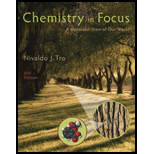
Concept explainers
The volume of a liquid can be measured with a piece of laboratory glass ware called a graduated cylinder. If a particular volume measurement using a graduated cylinder is reported as
Interpretation:
The degree of uncertainty in measuring the volume of a graduated cylinder is to be predicted.
Concept introduction:
In a reported quantity, all the digits are taken to be certain, except the last digit of the quantity.
The last digit is estimated and thus, it tells about the uncertainty in the measurement.
Answer to Problem 1SC
Solution: Option (b).
Explanation of Solution
Given information: The reported volume measured is
Reason for correct option:
In the given quantity, 23.4 mL, the digit 2 is at the ten’s place, the digit 3 is at the unit’s place and the digit 4 is at the tenth’s place.
The last digit in the given quantity is reported as 4, which is at the tenth’s place. So, the degree of uncertainty should be
The
Hence, option (b) is correct.
Reason for incorrect options:
Option (a) is incorrect because the last digit of the quantity is at the tenth’s place and not at the unit’s place.
Option (c) is incorrect because the uncertainty has been shown at the hundredth’s place. There is no digit at the hundredth’s place in the given quantity.
Option (d) is incorrect because the uncertainty has been shown at the thousandth’s place. There is no digit at the thousandth’s place in the given quantity.
Hence, options (a), (c), and (d) are incorrect.
Want to see more full solutions like this?
Chapter 2 Solutions
Chemistry In Focus
- The density of an irregularly shaped object was determined as follows. The mass of the object was found to be 28.90 g 0.03 g. A graduated cylinder was partially filled with water. The reading of the level of the water was 6.4 cm3 0.1 cm3. The object was dropped in the cylinder, and the level of the water rose to 9.8 cm3 0.1 cm3. What is the density of the object with appropriate error limits? (See Appendix 1.5.)arrow_forwardConsider the following rulers as instruments for the measurement of length. What would the uncertainty be in measurements made using the following? a. Ruler 1 b. Ruler 4arrow_forwarda 494 cm3 to mL, b 1.91 L to mL, c 874 cm3 to Larrow_forward
- 1.84 A student was given two metal cubes that looked similar. One was 1.05 cm on an edge and had a mass of 14.32 grams; the other was 2.66 cm on a side and had a mass of 215.3 grams. How can the student determine if these two cubes of metal are the same material using only the data given?arrow_forwardConsider the addition of “1 5.4” to “28.” What would a mathematician say the answer is? What would a scientist say? justify the scientist’s answer, not merely citing the rule, but explaining it.arrow_forwardFor the pin shown in Fig. 2.5, why is the third figure determined for the length of the pin uncertain? Considering that the third figure is uncertain, explain why the length of the pin is indicated as 2.85 cm rather than, for example, 2.83 or 2.87 cm.arrow_forward
- The density of osmium (the densest metal) is 22.57 g/cm3. If a 1.00-kg rectangular block of osmium has two dimensions of 4.00 cm 4.00 cm. calculate the third dimension of the block.arrow_forwarda 0.194 Gg to g, b 5.66 nm to m, c 0.00481 Mm to cmarrow_forwardTwo students were assigned to determine the mass of a sample of an unknown liquid. Student A used an ordinary laboratory balance that could determine mass to ±0.01 g. Student B used an analytical balance that could measure mass to ±0.1 mg. Each made four measurements, giving the following results: Student A: 8.19 g, 8.22 g, 8.21 g, 8.25 g Student B: 8.2210 g, 8.2210 g, 8.2209 g, 8.2210 g 2. Which student is more precise? A Barrow_forward

 ChemistryChemistryISBN:9781305957404Author:Steven S. Zumdahl, Susan A. Zumdahl, Donald J. DeCostePublisher:Cengage Learning
ChemistryChemistryISBN:9781305957404Author:Steven S. Zumdahl, Susan A. Zumdahl, Donald J. DeCostePublisher:Cengage Learning General Chemistry - Standalone book (MindTap Cour...ChemistryISBN:9781305580343Author:Steven D. Gammon, Ebbing, Darrell Ebbing, Steven D., Darrell; Gammon, Darrell Ebbing; Steven D. Gammon, Darrell D.; Gammon, Ebbing; Steven D. Gammon; DarrellPublisher:Cengage Learning
General Chemistry - Standalone book (MindTap Cour...ChemistryISBN:9781305580343Author:Steven D. Gammon, Ebbing, Darrell Ebbing, Steven D., Darrell; Gammon, Darrell Ebbing; Steven D. Gammon, Darrell D.; Gammon, Ebbing; Steven D. Gammon; DarrellPublisher:Cengage Learning General, Organic, and Biological ChemistryChemistryISBN:9781285853918Author:H. Stephen StokerPublisher:Cengage LearningChemistry: Matter and ChangeChemistryISBN:9780078746376Author:Dinah Zike, Laurel Dingrando, Nicholas Hainen, Cheryl WistromPublisher:Glencoe/McGraw-Hill School Pub Co
General, Organic, and Biological ChemistryChemistryISBN:9781285853918Author:H. Stephen StokerPublisher:Cengage LearningChemistry: Matter and ChangeChemistryISBN:9780078746376Author:Dinah Zike, Laurel Dingrando, Nicholas Hainen, Cheryl WistromPublisher:Glencoe/McGraw-Hill School Pub Co





